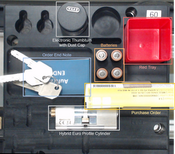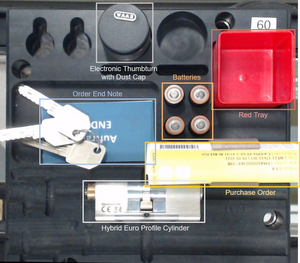Information
- Publication Type: Bachelor Thesis
- Workgroup(s)/Project(s):
- Date: June 2025
- Date (Start): September 2024
- Date (End): June 2025
- Matrikelnummer: 11909911
- First Supervisor:
Abstract
This thesis investigates data-efficient deep learning methods for visual assembly ver- ification in a highly customizable electronic lock production line. We examine three data-centric strategies. First, ROI-based methods leverage the fixed geometry of the workpiece carriers by reformulating object detection as a set of classification or regression tasks over predefined regions. Second, pseudo bounding boxes are created by combining image-level labels with known part positions to automatically generate object detection annotations without manual labelling. Third, synthetic training data is produced by compositing cropped part images with background scenes, thereby increasing dataset diversity and reducing the need for extensive manual data collection. These methods are evaluated on a real-world dataset collected during regular production to assess their effectiveness in reducing manual annotation effort. We provide a compre- hensive comparison of data-centric approaches, highlighting their respective strengths and limitations. The results demonstrate that leveraging the structured nature of the assembly environment enables accurate model performance with substantially reduced annotation requirements.Additional Files and Images
Additional images and videos
 teaser:
An example from the dataset presented in the thesis showing a Double-sided hybrid Euro cylinder with electronic thumbturn and keyway
teaser:
An example from the dataset presented in the thesis showing a Double-sided hybrid Euro cylinder with electronic thumbturn and keyway
Additional files
Weblinks
No further information available.BibTeX
@bachelorsthesis{Braunsperger-2025_bsc,
title = "Data-Centric Methods for Efficient Deep Assembly
Verification: A Case Study in Electronic Lock Manufacturing",
author = "Martin Braunsperger",
year = "2025",
abstract = "This thesis investigates data-efficient deep learning
methods for visual assembly ver- ification in a highly
customizable electronic lock production line. We examine
three data-centric strategies. First, ROI-based methods
leverage the fixed geometry of the workpiece carriers by
reformulating object detection as a set of classification or
regression tasks over predefined regions. Second, pseudo
bounding boxes are created by combining image-level labels
with known part positions to automatically generate object
detection annotations without manual labelling. Third,
synthetic training data is produced by compositing cropped
part images with background scenes, thereby increasing
dataset diversity and reducing the need for extensive manual
data collection. These methods are evaluated on a real-world
dataset collected during regular production to assess their
effectiveness in reducing manual annotation effort. We
provide a compre- hensive comparison of data-centric
approaches, highlighting their respective strengths and
limitations. The results demonstrate that leveraging the
structured nature of the assembly environment enables
accurate model performance with substantially reduced
annotation requirements.",
month = jun,
address = "Favoritenstrasse 9-11/E193-02, A-1040 Vienna, Austria",
school = "Research Unit of Computer Graphics, Institute of Visual
Computing and Human-Centered Technology, Faculty of
Informatics, TU Wien ",
URL = "https://www.cg.tuwien.ac.at/research/publications/2025/Braunsperger-2025_bsc/",
}


